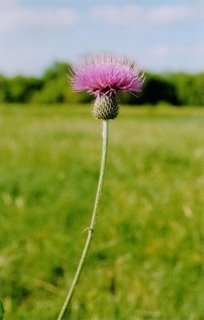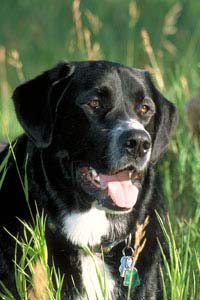
Milk thistle is believed to protect and regenerate the liver in most liver conditions such as Cirrhosis, Jaundice, Hepatitis, and Cholangitis. It may be one of the best examples of preventative treatment that we have today as it not only seems to protect each cell of the liver from incoming toxins, but simultaneously encourages the liver to cleanse itself of damaging substances, such as alcohol, drugs, medications, mercury and heavy metals, pesticides, and even the most poisonous of mushrooms, the Amanita. (Please note: NEVER knowingly eat an Amanita. This single, widespread species of mushroom is solely responsible for the majority of fatal and otherwise serious mushroom poisoning cases, worldwide as well as in North America.)
Milk thistle is wonderful and appropriate for anyone who is under stress, uses alcohol, recreational drugs, prescription medications, or lives in today's modern times of pesticides, environmental toxins, and pollution--virtually every person in a developed nation.
One of the special qualities of milk thistle is that it apparently cleanses and detoxifies an overburdened and stagnant liver while also being able to strengthen and tonify a weak liver; thus delivering potent help to clogs and deficiencies. One of the tasks of the liver is to cleanse the blood. If the liver energy is stagnant it will be unable to effectively cleanse the blood; this can contribute to skin problems ranging from acne to psoriasis and eczema. Milk thistle is a powerful herb used to support the liver to purify the blood and is said to be of the best herbs for the skin disorders mentioned above. It is also often used for for treating congestion of the kidneys, spleen, and pelvic region.
The Bowels:
Milk thistle is a gentle and mild laxative due to its ability to increase bile secretion and flow in the intestinal tract. This herb can have actions ranging from lubrication and softening of the stools to a mild laxative effect, to actually balancing individuals that alternate between diarrhea and constipation.
Inflammation:
Milk thistle is also a demulcent, meaning that it soothes and moistens the mucus membranes, kidney and bladder irritations and inflammations in general. Being a demulcent, it also greatly softens and moistens the skin. Patients with skin problems ranging from acne to severe eczema have reported a clearing of skin impurities, healing of redness and inflammation, a dramatic softening and moistening of dry, cracking skin, and a noticeable glow and radiance to the skin quality.
Liver Disease - Hepatitis and Beyond:
Milk thistle has been found in recent years to be a major player in the treatment of liver disease, because it is said to help lower enzyme levels and facilitate the liver in its process of detoxifying the body. Among all known herbal remedies, milk thistle finds its place as the leader in herbs to treat liver disease. Health care providers have often prescribed milk thistle for hepatitis (to keep down inflammation), cirrhosis (to soften the liver), liver cancer (to aid in detoxification), and many dysfunctions of the gall bladder. It also seems to help protect the liver for those individuals that are taking prescription medications known to elevate liver enzymes.
Gall Bladder Disease:
Because milk thistle is both a demulcent and stimulates bile flow, it is a natural to use for a wide array of gall bladder diseases and symptoms. Milk thistle can calm down an inflamed gall bladder while at the same time helping to clear out any stagnation that might be present. When using milk thistle to combat gall bladder symptoms, it is important to verify that there are no gallstones present which would be too large for the gall bladder to pass. The only way that this can be known is to visit your personal physician or health care provider for verification.
Silymarin:
Silymarin is the key constituent in milk thistle seed. Silymarin is a flavonoid composed of 4 isomers: silybinin, silychristin, silydianin, isosilybinin. Silymarin is only soluble in alcohol (not water), thus making an alcohol extract the preferred medium of extraction. Much research has been done on silymarin and at this time the only known source is the milk thistle seed.
Side Effects:
There are no known contra-indications to milk thistle supplements. There is, however, a caution for HIV patients, because many medications taken by individuals diagnosed with HIV/AIDS, such as protease inhibitors and non-nukes are processed by the liver enzyme CYP3A4 which is decreased by Silymarin. If milk thistle is taken by someone using protease inhibitors or non-nukes, it has the potential to raise levels of these drugs. This should not be a concern as long as levels of these drugs are monitored closely and dosage is adjusted to reach the desired levels.
Side effects from milk thistle happen only rarely, but may include stomach pain, nausea, vomiting, diarrhea, headache, rash or other skin reactions, joint pain, impotence, and anaphylaxis. The last two reactions listed are extremely rare.
Milk thistle (just like most other herbal substances) should probably not be used by pregnant or breastfeeding women, though historically milk thistle has been said to increase milk flow in lactating mothers, and no harmful effects have been found so far.
Properties:
Hepatoprotective: Protects liver cells from incoming toxins, thereby also allowing it to more effectively process and release toxins that are already built up in the system.
Hepatotonic: Strengthens the liver to function more effectively.
Demulcent: Soothes and moistens. Used for both kidney and bladder irritations, as well as mucous membranes and inflammations of the skin and integumentary system.
Laxative: Mildly lubricates the bowels.





